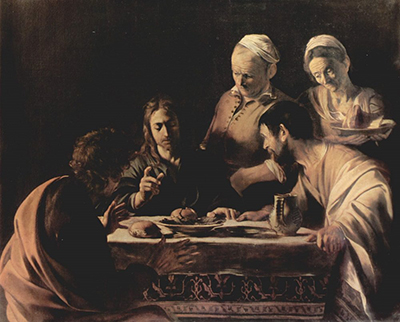In the year 1606, famous Italian artist Caravaggio produced the painting Supper at Emmaus. This celebrated picture is housed in the capital Milan. Supper at Emmaus 1606 describes the event that unfolded as recorded in the Holy Bible, specifically in the book of Luke 24.
Although the painting outlines Caravaggio's work, he is known to have produced other biblically related paintings such as The Death of The Virgin and The Crucifixion of St Peter among others. Based on the gospel of St. Luke in the New Testament, Jesus Christ is recorded to have revealed himself to a pair of his disciples, Cleopas and Luke. At this point, the two are oblivious of the unfolding. Caravaggio tries to portray the happening in the most descriptive manner. From the painting, the scripture of Luke 24 is brought to perspective. He decides to represent one exact moment scenario where the apostles noticed the resurrected Christ. The expression of this painting gives the observer a close feel on the actual event in Emmaus.
It is not clear as to whom Caravaggio intended the painting for. Even though the picture is believed to have been painted in Rome, there is a lot to learn and relate with respect to the master piece. Roman Catholics and other faithful globally can be able to look at this painting as a faith reference point. Many get excited as they are able to worship God and develop faith in his love. The painting was painted at a time when the church felt the need to communicate important information to their faithful. What better way to do than a painting expression? Caravaggio's brand of art can only be defined as great and target specific.
Every expression in the painting is carefully crafted. For example, the extended disciple's hand on the right side of the picture is seen to touch the canvas from within. On the other hand, the elbow of the second apostle appears to be tearing through the canvas. As for the fruit basket, the drawing is an expression of bounty as Christ is resurrected. The image is a sign of hope and new beginnings. The fruits are attractively displayed to enhance the hope message. Finally, the floor in the picture is the normal floor. It’s an expression of the real life of a follower of Christ.
Caravaggio's contribution towards Supper at Emmaus 1606 can only be admired and respected. The timing and expression of the painting not only promotes the unfolding events at Emmaus but also show the quality of the artist. Biblically, the faithful can relate to the content. They are able to have a literal reference to Christ's wonderful miracle of resurrection. Whichever way you see it, an art like this is worth centuries of exhibitions.




